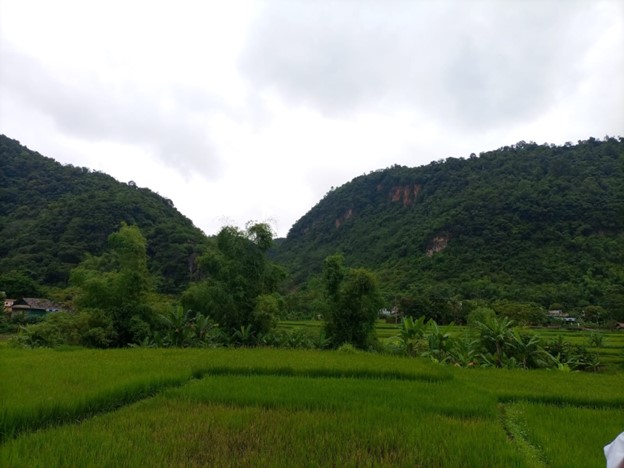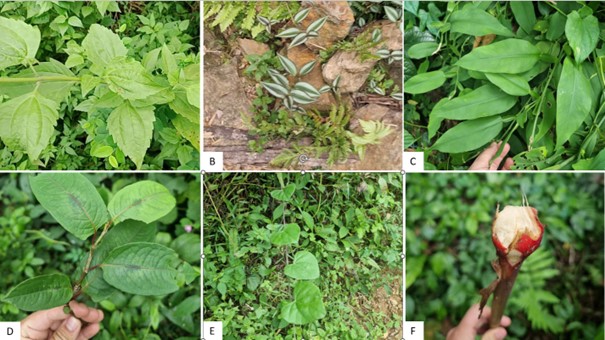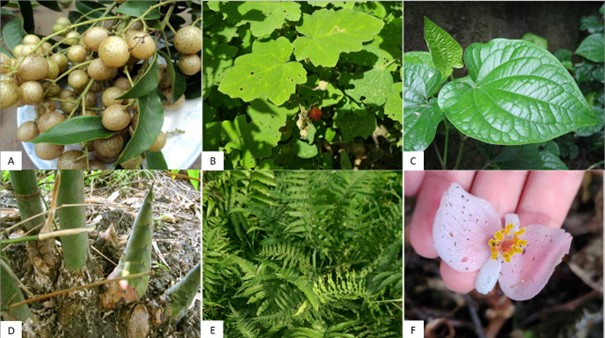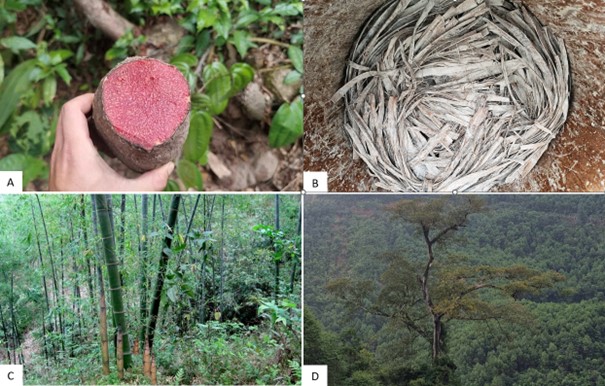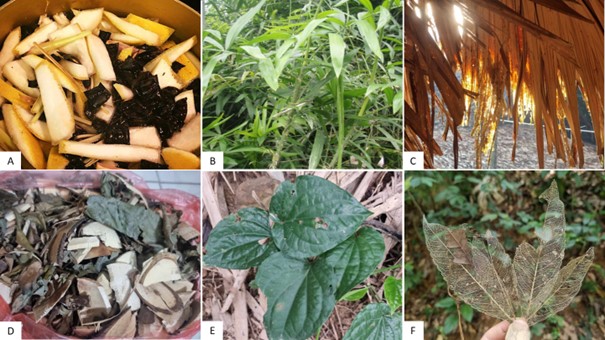“Harvesting Hope”
The promising applications of plants in Hoa Binh
By Queenny Lopez Alvarado, Alexandra Reinhild Berndt, Beryl Nchieh Kiyam, Gabriela Andrea Ochoa Patiño, Abra Lea Simonic, Hoàng Long Vũ
The goal of our stay in Hoa Binh was to study plants, find out their current state, identify those most threatened by human activity, and recommend strategies for better conservation of these plant communities. The quest to achieve this goal led us through mountain trails, forests, and the heart of three communities: Mai Hich, Ban Sung, and Da Bac, where we were fascinated by the rich biodiversity, beautiful environments, crafts, cuisine, and rich traditional heritage of local ethnic communities.
During our stay in Hoa Binh, we were able to achieve our objective despite inevitable high and low moments. Being six inquisitive minds that made up the biodiversity team, we sought to go beyond our objective of collecting, identifying, and analyzing plants to draw results, to discover what plant communities had to offer to the local people. It was amazing to find out how much they had to offer. Stay with us as we share our journey and findings on the uses or benefits of the plants we researched in Hoa Binh to local communities and beyond.
Our first stop was the local market in Ban Lac, where we found various plant-based medicinal products, including herbal teas from dried flowers, leaves, and tree bark. We later learned from Nguyen et al. (2019) that the market created opportunities for boosting the local economy and exchanging knowledge on medicinal plants. Additionally, we found out that the Vietnamese government also fosters policies promoting medicinal plant production (Ngo et al., 2022). Medicinal plants are crucial for local communities since they are a vital part of the local healthcare system, especially since hospitals are far away (Huong et al., 2022). The knowledge of traditional medicine production is anchored in ethnic communities. The Tay ethnic group knows, for example, how to use the leaves, roots, and bark of plants to prepare medicine against common illnesses such as stomach aches, headaches, fractures, or fever (Huong et al., 2022).
(a) Ageratum conyzoides leaves help to relieve stomach ache; (b) Tradescantia pallida is used in herbal baths and helps to reduce pimples; (c) Rhaphidophora sp. is used for treatment of coughing in children; (d) Persicaria sp. – leaves are crushed, boiled, and placed on the abdomen to help relieve abdominal pain during menstruation; (e) Ipomoea obscura has proven antibacterial properties and are daily use as treatment for pimples. Leaves can be boiled and drunk for deworming; (f) Canna sp. tuber is used as a detox.
Talking about plants, how can we forget the number of plants and vegetables that were served as food during the Living Lab? Our meals included bamboo shoots, which were often presented on banana leaves. Our rice was served inside bamboo sticks, and our pork was grilled with Clausena indica leaves, prepared with spices such as anise, cinnamon, or citrus, and then wrapped in Michelia tonkinensis leaves. From eating a wide variety of plants served at almost every meal, we realized that in Hoa Binh, many people depend on edible plants for food. Our chat with some indigenes of Ban Sung village, also supported by what we found in Talukdar et al. (2021), revealed that plants in this region are known to be rich in nutrients such as proteins and vitamins, which are beneficial for human health.
(a) Leaves and fruits of Clausena indica are used as spices for food; (b) Leaves and fruits of Rubus sp. can be eaten directly; (c) Leaves of Piper sarmentosum are eaten with red meat; (d) Bamboo shoots; (e) Young leaves of Diplazium esculentum are common stirred fried; (f) leaves, stems, and flowers of Begonia sp., can be cooked for sour soup.
Aside from being used as food and medicine, the walls and furniture in our homestays were crafted from bamboo and rattan, both essential Non-Timber Forest Products (NTFPs) relevant to local communities in Hoa Binh. This choice of material also displays the rich traditions and culture of the Muong and Dao people. Women in the Muong community were known for their clothing, dyed using indigo leaves and bee sap (Luu-dam et al., 2016). We had the opportunity to witness this type of embroidery in Ban Sung village, where we further learned that clothing is essential for the community since it represents their identity and culture.
(a) Dioscorea cirrhosa is used as food and to dye papers and clothes in traditional events; (b) barks from Rhamnoneuron balansae are used to produce papers; (c) Bamboo Forest used in the construction and production of handicrafts; (d) Old trees play a vital role in cultural lives of Dao communities (Image Credit 4b, 4c: Hinoart-hinoart.com/)
Chatting with people of the Dao and Muong communities, we realized that plants and other non-timber forest products also found their way into daily cosmetics. Boiled water derived from the dried fruit of the black locust, dried pomelo peel, and crushed lemongrass are used for hair care. It was traditionally believed to have antimicrobial properties, strengthening hair and preventing hair loss. Bamboo ashes, obtained from burning, are used to aid in teeth whitening processes. In contrast, when black teeth were the beauty standard in the past, betel and areca were chewed throughout the day to dye the teeth black and prevent oral infections (Zumbroich, 2009). Ginger, with its invigorating properties, is used for body scrubs.
While in Sung village, we also had a chance to experience herbal baths with over 30 medicinal plants. Initially, it felt like normal hot water. However, after around 10 minutes, we realized the effects. We began to sweat, and upon stepping out of the bath, we were very sleepy and decided to go to bed. These baths are known to ease tense muscles (Ekiert et al., 2020). Traditional herbal baths are tourism products provided by local people in the Sung village, opening a significant economic potential for local communities.
Across generations, ethnic communities have developed a profound knowledge of plants in their immediate surroundings for various practical purposes. One notable tradition involves brewing a blend of lemongrass, chili, and garlic. It serves as a potent natural pesticide and insect repellent. In the north of Vietnam, the Rhamnoneuron balansae plant is used for crafting Rhamnoneuron paper. This paper is known for its durability, natural color, and soft texture. Additionally, we saw handcrafted items and furniture from plants like Daemonorops sp. and Calamus sp., also referred to as rattan and known for flexibility and durability. The Dao and Muong people even constructed roofs by layering the leaves of the Rhapis excelsa plant.
(a) Combination of black locust, pomelo peel, and crushed lemongrass for hair washing; (b) Rattan used to make furniture; (c) Roof made from Rhapis excelsa; (d) Mixture of dried leaves and stems used for traditional herbal bath; (e) Betel leaves; (f) Dried leaves that can be used as ornaments in the house.
We also learned that some old trees have an important meaning for the local population: Trees of Ficus sp. and Dracontomelon sp. are believed to harbor spirits within them, a belief that instills reverence among local communities, leading to their careful preservation and protection. These trees hold symbolic significance, providing people with a profound sense of belonging and connection to their homeland (McElwee et al., 2022). This showed us the strong link between nature and local culture.
Through the living lab, our stay in Hoa Binh made us realize the critical role of plants and other non-forest timber products in local households, health care systems, culture, and economy. Our trip here highlighted not only the practical use of natural resources but also emphasized the vital relationship between communities and the environment, as well as the importance of biodiversity in the day-to-day life of the local community.
References
Ekiert, H., Pajor, J., Klin, P., Rzepiela, A., Ślesak, H., & Szopa, A. (2020). Significance of Artemisia vulgaris L. (Common Mugwort) in the history of medicine and its possible contemporary applications substantiated by phytochemical and pharmacological studies. Molecules, 25(19), 4415.
Huong, L. T. T., Hung, N. P., Murthy, H. N., & Thanh, N. T. (2022). Medicinal Plants Used by the Tay Ethnic Group, Thai Nguyen Province, Vietnam. In Herbs and Spices-New Advances. IntechOpen.
Luu-dam, N. A., Ninh, B. K., & Sumimura, Y. (2016). Ethnobotany of colorant plants in ethnic communities in Northern Vietnam. Anthropology, 4(158), 2332-0915.
Ngo, H. K., Nguyen, A. T., Nguyen, D. B., Le, N. A., Nguyen, T. H., & Luc, H. (2022). Value Chain Analysis of Medicinal Plants in Geoparks: Livelihoods of Ethnic Minorities based on Non-Timber Forest Products (NTFPs) in Vietnam.
Nguyen, T. S., Xia, N. H., Van Chu, T., & Van Sam, H. (2019). Ethnobotanical study on medicinal plants in traditional markets of Son La province, Vietnam. Forest Soc, 3(2), 171-92.
McElwee, P., Vũ, H., Võ, G., & Lê, D. (2022). Patriotism, place, and provisioning: assessing cultural ecosystem services through longitudinal and historical studies in Vietnam. Ecology and Society, 27(1)
Talukdar, N. R., Choudhury, P., Barbhuiya, R. A., & Singh, B. (2021). Importance of non-timber forest products (NTFPs) in rural livelihood: A study in Patharia Hills Reserve Forest, northeast India. Trees, Forests and People, 3, 100042.
Zumbroich, T. J. (2009). The ethnobotany of teeth blackening in Southeast Asia. Ethnobotany Research and Applications, 7, 381-398.
Picture Reference
Hino Art Materials (n.d.). Hino Art Materials. Retrieved from https://hinoart.com/
